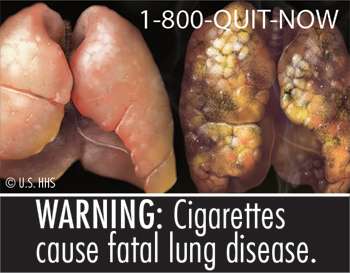Graphic pictures on cigarette packs would significantly reduce smoking death rate, study finds

Using prominent, graphic pictures on cigarette packs warning against smoking could avert more than 652,000 deaths, up to 92,000 low birth weight infants, up to 145,000 preterm births, and about 1,000 cases of sudden infant deaths in the U.S. over the next 50 years, say researchers from Georgetown Lombardi Comprehensive Cancer Center.
Their study, published online Nov. 3 in the journal Tobacco Control, is the first to estimate the effects of pictorial warnings on cigarette packs on the health of both adults and infants in the U.S
Although more than 70 nations have adopted or are considering adopting the World Health Organization's Framework Convention for Tobacco Control to use such front and back of-the-pack pictorial warnings—an example is a Brazilian photo of a father with a tracheotomy—they have not been implemented in the US. Pictorial warnings have been required by law, but an industry lawsuit stalled implementation of this requirement. Currently, a text-only warning appears on the side of cigarette packs in the U.S.
The study used a tobacco control policy model, SimSmoke, developed by Georgetown Lombardi's David T. Levy, PhD, which looks at the effects of past smoking policies as well as future policies. SimSmoke is peer-reviewed, and has been used and validated in more than 20 countries.
In this study, Levy and his colleagues, who included investigators at the University of Waterloo, Ontario, and the University of South Carolina, looked at changes in smoking rates in Australia, Canada and the United Kingdom, which have already implement prominent pictorial warning labels (PWLs). For example, eight years after PWLs were implemented in Canada, there was an estimated 12 percent - 20 percent relative reduction in smoking prevalence. After PWLs began to be used in Australia in 2006, adult smoking prevalence fell from 21.3 percent in 2007 to 19 percent in 2008. After implementation in the UK in 2008, smoking prevalence fell 10 percent in the following year.
The researchers used these and other studies and, employing the SimSmoke model, estimated that implementing PWLs in the U.S. would directly reduce smoking prevalence in relative terms by 5 percent in the near term, increasing to 10 percent over the long-term. If implemented in 2016, PWLs are estimated to reduce the number of smoking attributable deaths (heart disease, lung cancer and COPD) by an estimated 652,800 by 2065 and to prevent more than 46,600 cases of low-birth weights, 73,600 cases of preterm birth, and 1,000 SIDS deaths.
"The bottom line is that requiring large pictorial warnings would help protect the public health of people in the United States," says Levy, a professor of oncology. "There is a direct association between these warnings and increased smoking cessation and reduced smoking initiation and prevalence. That would lead to significant reduction of death and morbidity, as well as medical cost."
More information: David T Levy et al, Public health benefits from pictorial health warnings on US cigarette packs: a SimSmoke simulation, Tobacco Control (2016). DOI: 10.1136/tobaccocontrol-2016-053087



















